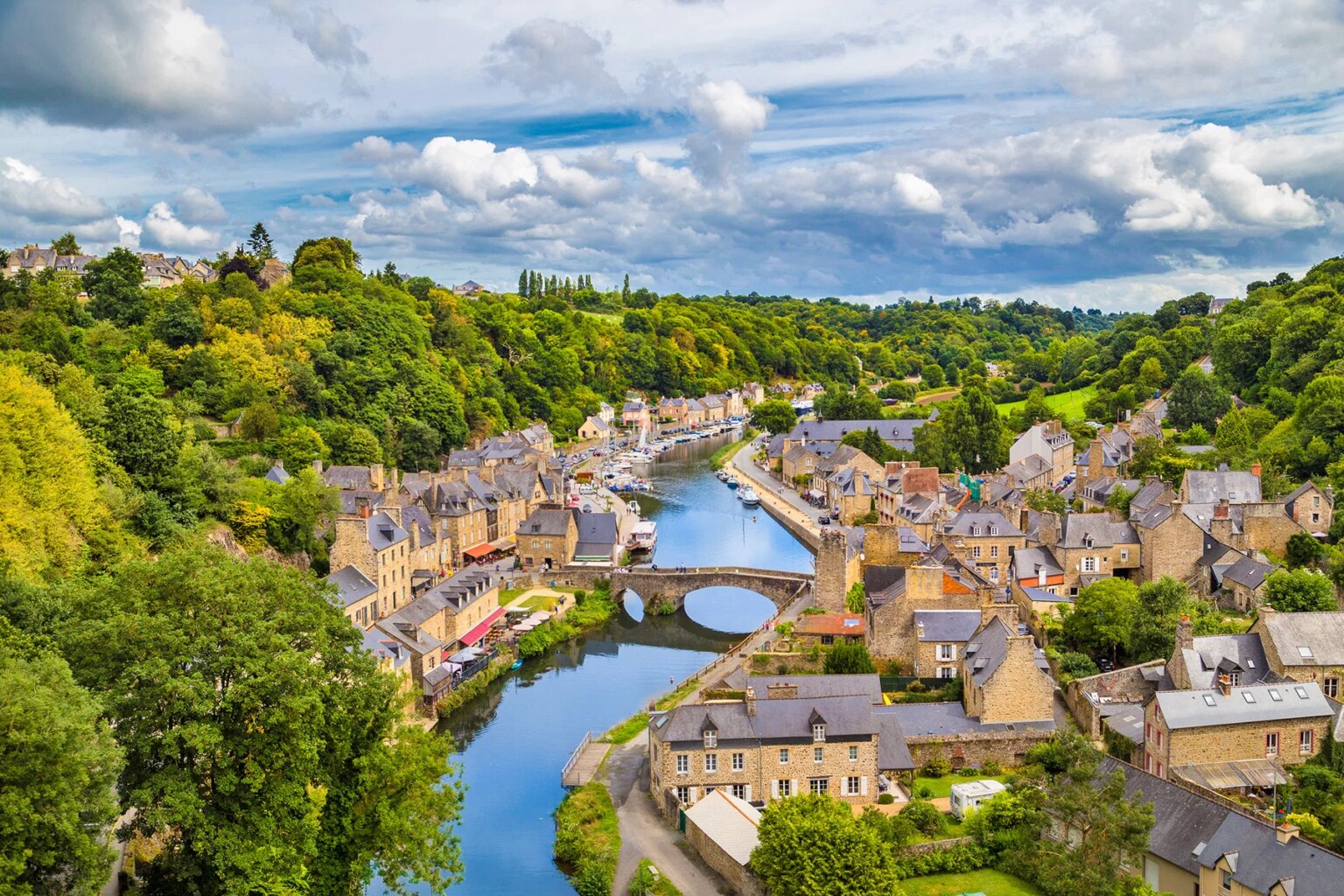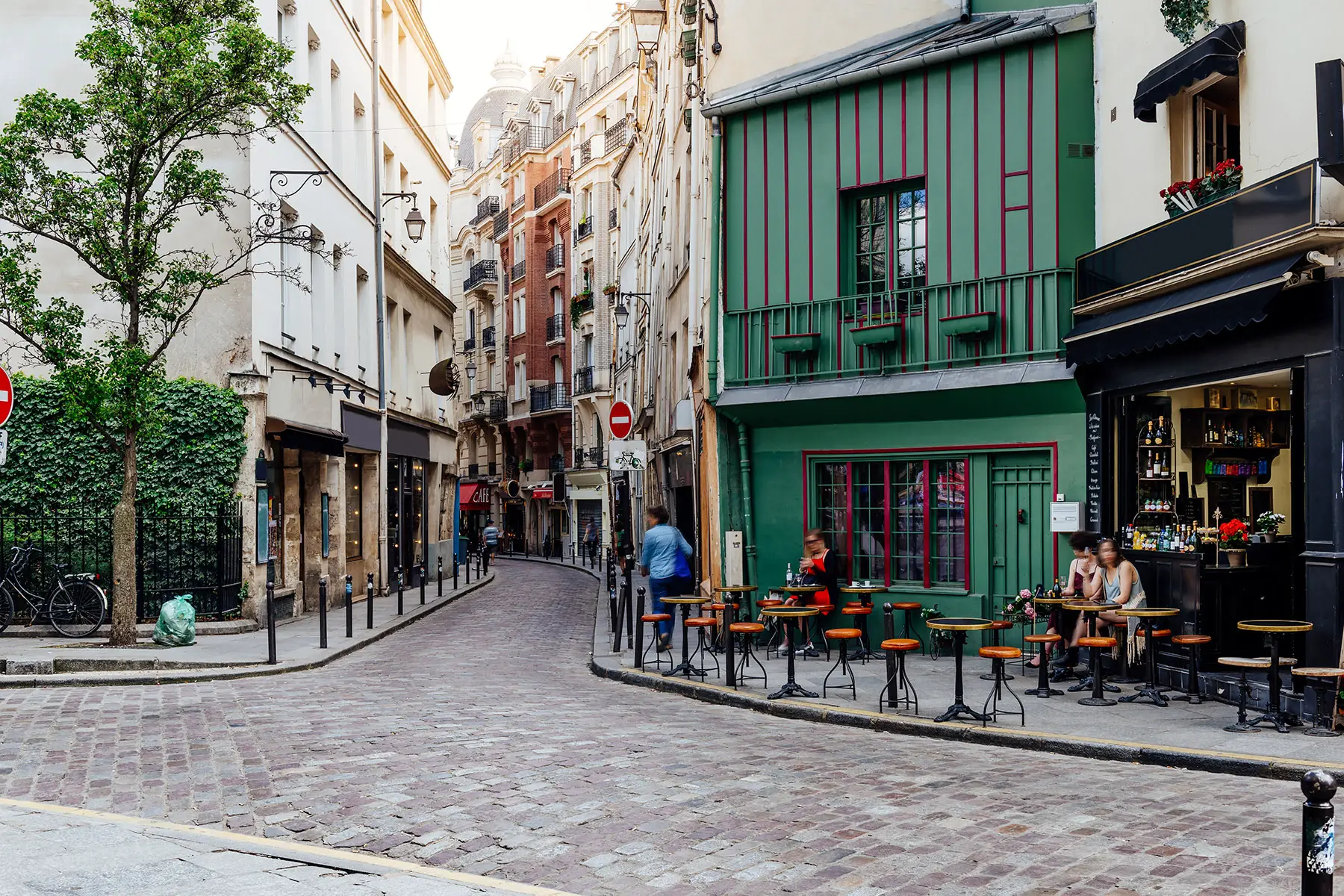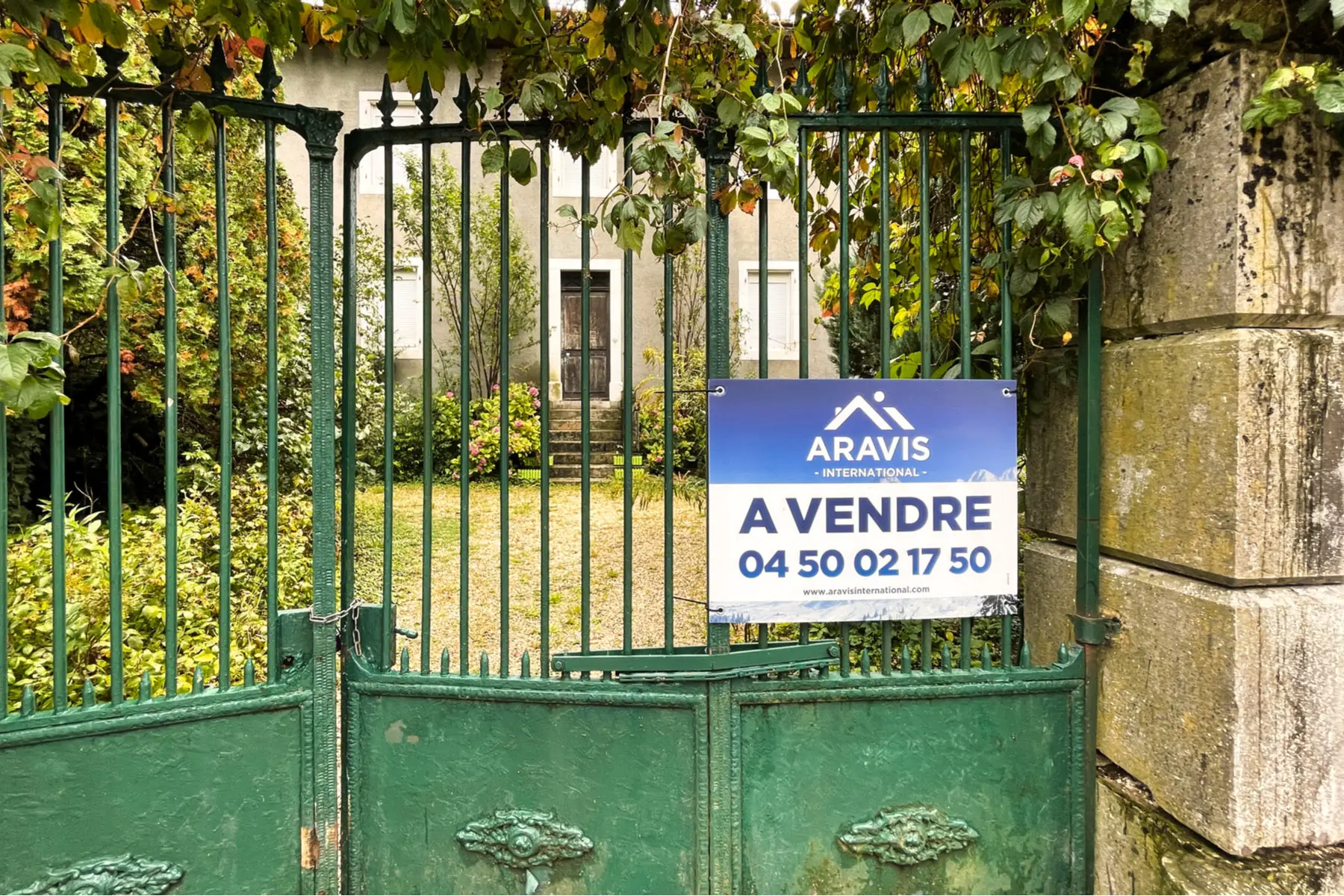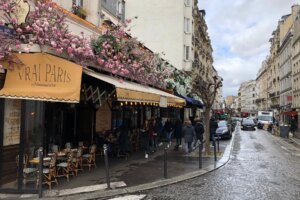Nestled on the stunning northwestern coast of France, Brittany boasts natural beauty, a rich history, and a vibrant Celtic culture. Also known as ‘Little Britain’, the hilly peninsula features rugged coastlines, charming countryside, and quaint towns, offering a variety of landscapes to those who call it home.
If you enjoy the great outdoors and delicious cuisine, then Brittany may be the place for you. So to help you get to know this captivating coastal region of France along with its different towns and cities, this article covers the following:
Sirelo
It's no secret that moving abroad can be stressful. Sirelo's team of removal advisers is here to help. They provide five free quotes from international shipping companies so you can find the best options at the best prices. Take the stress out of your relocation to France with Sirelo.
An overview of Brittany
Located in northwestern France, Brittany (French: Bretagne, Breton: Breizh) has a distinct identity that has largely been shaped by its Celtic roots.
Indeed, the Celts were the first known inhabitants of Brittany, although historians believe that they mixed with earlier settlers who built the Carnac stones that still stand there today.

The Celtic heritage is still very much alive today too, with residents of the region – or Bretons – upholding traditional music and dance, as well as their own language from centuries ago. They proudly celebrate their culture during regional festivals such as Fest Noz, which means ‘night party’ in French.
Brittany is a melting pot of cultures and as such, Bretons have a warm and inviting nature. While most people speak French, they cherish diversity and welcome the vibrant expat communities – many of which are British – that call it home.
Brittany is famous for its thriving agricultural sector, which includes the dairy and seafood industries. Notably, the region’s dairy farming is famous for producing high-quality butter and cheese.
Moreover, Brittany plays a significant role in the French fishing industry, serving as a primary source of seafood such as oysters, mussels, and fish. In recent years, Brittany has also experienced growth in the technology and renewable energy sectors.
Overall, Brittany offers a high quality of life, including access to excellent healthcare and education facilities. Although living costs can vary depending on the area, coastal regions are generally more expensive due to their natural beauty and desirability, which makes them popular among residents and tourists alike. That said, the overall cost of living in Rennes, Brittany’s capital, is significantly cheaper than it is in Paris.
How do you find housing in Brittany?
Whether you are looking to buy, rent, or find a place to stay short-term in Brittany, there are many options available.
For instance, you might want to ask a real estate agency (agences immobilieres) for help. Notably, there are many of these who speak multiple languages which can make your search a bit easier.
Alternatively, you can search property websites to find rentals, homes for sale, and other accommodations in Brittany. Some of the better-known sites include:
- Airbnb EU: for short-term rentals of a room or full property
- Blueground: for renting designer, furnished apartments
- HousingAnywhere: for apartments, studios, and shared accommodation
- Spotahome: good for short-term lets and flatshares
Other ways to find housing include joining local social media groups or forums and enquiring by word of mouth if you already have a personal network in the region.
Typical Breton housing
Brittany offers a diverse range of housing options among its various urban and rural landscapes.
For example, you will find charming stone cottages with special features such as slate roofs and colorful shutters in the countryside. Notably, these homes often have big gardens, making them popular among families with children.
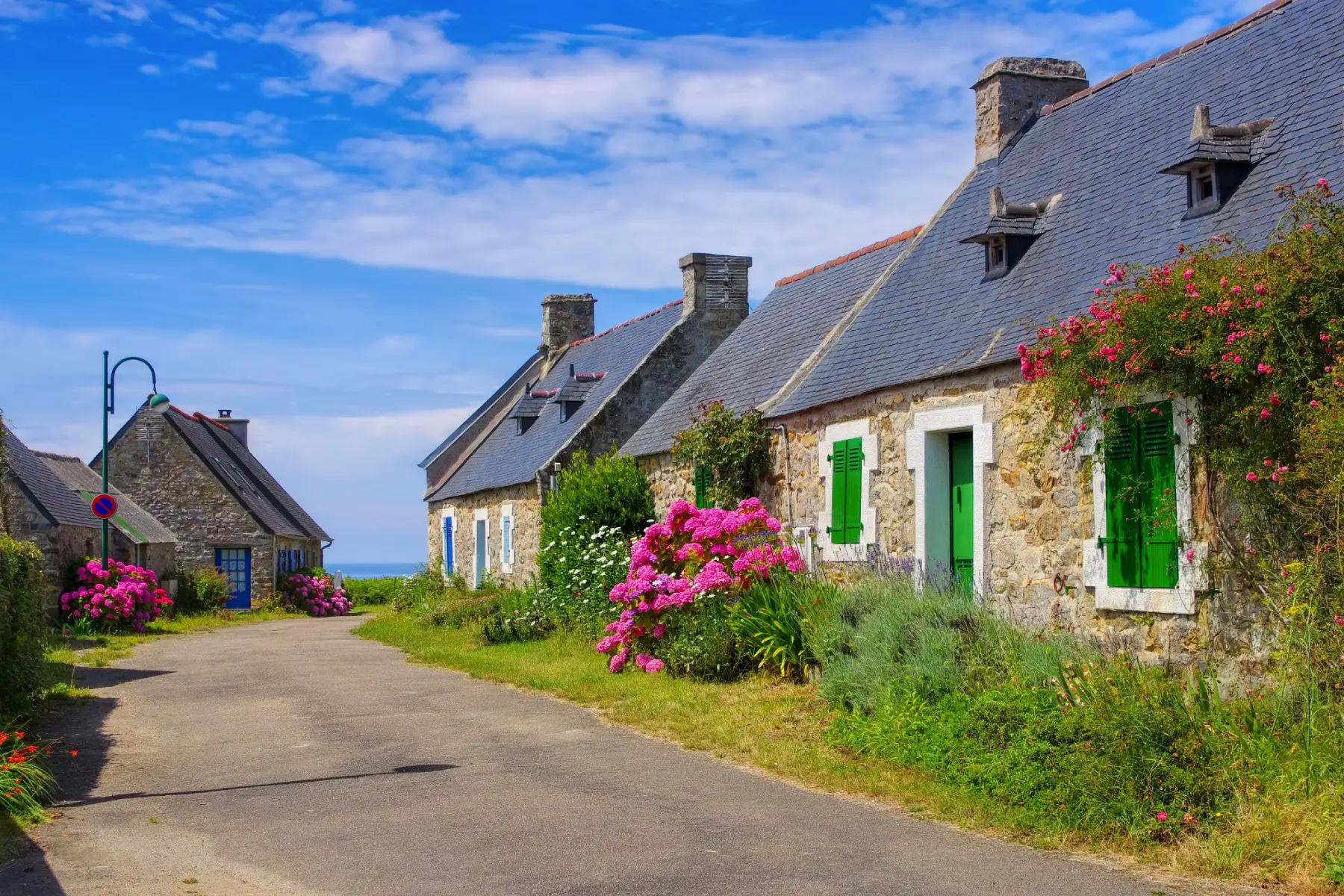
In cities like Rennes and Brest, on the other hand, you can find modestly-sized apartments that range from 30 to 100 square meters. And if you prefer to live by the coast, some properties come with lovely sea views and private outdoor spaces. That said, they can be costly.
Renting property
Naturally, if you want to rent a home in Brittany, prices and availability change depending on where you look. For example, in the countryside, you can usually find cheaper rentals, from about €400 per month, in small villages and towns.
However, in cities like Rennes and Brest, finding a rental can be more competitive and therefore more expensive. For example, a one-bedroom apartment in the center of Rennes ranges from €600 to €800 per month and €500 to €600 outside the center.
And in coastal places like Saint-Malo and Quiberon, prices can be even higher due to their prime location. For instance, the average rent for a one-bedroom apartment in Saint-Malo was €1,461 in October 2023.
Buying property
Similar to renting, you can go through an agency or search housing websites to find a suitable property in Brittany.
Again, the cost of buying a property depends on the location. For example, in more rural areas, a home can cost from €80,000 while in cities, prices usually start at €150,000. However, if you are looking to live in coastal areas, luxury properties start at €500,000.
It is also worth noting that property prices will likely continue to increase, due to a growing housing demand in recent years.
The best towns and cities in Brittany
Unlike more urban areas like Paris or Marseille, Brittany is not divided into neighborhoods, but rather two regions: Upper Brittany (Haute-Bretagne) and Lower Brittany (Basse-Bretagne).
Upper Brittany is made up of the eastern Gallo-speaking areas, while Lower Brittany is made up of the western, Breton-speaking areas.
Moreover, these two regions are further divided into four main administrative departments: Côtes-d’Armor, Finistère, Ille-et-Vilaine, and Morbihan. These administrative departments contain several popular towns and cities, which each have their own unique character and charm.
Below is an overview of some of the most popular towns and cities to live in Brittany.
Brest
If you enjoy having a deep connection to the sea, then Brest is another great option. Located on Brittany’s west coast, in the Finistère department, the port city has a rich naval heritage and is home to the French Navy.
As you might expect, there are many opportunities to enjoy maritime activities in Brest, including sailing, fishing, and visiting Océanopolis, the biggest open-air aquarium in Europe.
The overall cost of living in Brest is relatively low when compared to other locations on this list, with the average rent for a one-bedroom apartment sitting at €445 in October 2023. Moreover, utilities such as electricity and water are also reasonable.
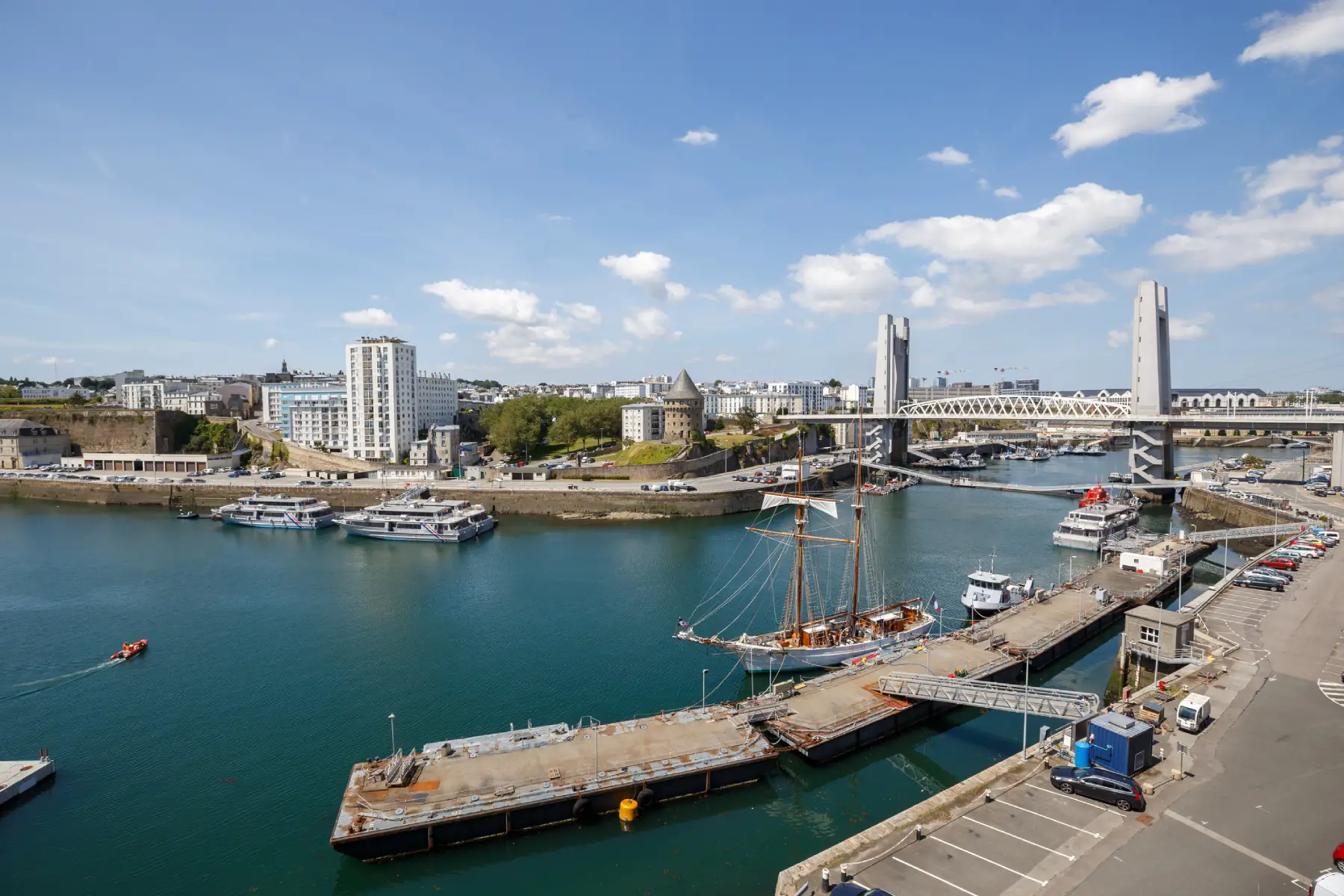
Groceries are also affordable, especially if you shop at local markets and supermarkets. That said, eating out at restaurants won’t hurt your wallet – especially if you dine at local venues. If you do feel like splurging, though, there are 19 Michelin-starred restaurants to choose from in the city. There are many free or low-cost activities to enjoy too, which is great if you are trying to save money.
In terms of education, the University of Western Brittany (Université de Bretagne-Occidentale) is an ideal place to study marine sciences and oceanography. Those looking for work will also find a diverse economy that is driven by the telecommunications, technology, and renewable energy industries, which offer many job prospects.
Getting around Brest is easy, thanks to the Brest Bretagne Airport and the TGV (Train à Grande Vitesse) train route. Its public transport network of trams, buses, and ferries is also cheap and easy to navigate. If you prefer, however, you can get around on foot.
However, beware of the weather, as the city has mild temperatures all year but can experience frequent rain due to its maritime climate.
Concarneau
If you don’t mind living away from the hustle and bustle in a small fishing town, then Concarneau might be a viable option.
Embedded in one of the most beautiful bays in Brittany, the walled town has a history that is closely tied to the sea. It relies heavily on fishing, particularly for tuna and sardines, and is therefore great for enjoying seafood. It is also well known for its traditional Breton dishes
Concarneau is also popular among those looking for old-fashioned charm, nice beaches, and water activities. It also hosts many exciting festivals and events throughout the year, ranging from music concerts to cultural celebrations.
There are several types of housing on offer in the city, including stone houses – which are mainly found in the town center – traditional, rectangular-shaped maisons à auvent (canopy houses), and rural longère houses with thatched or slated roofs.
However, it is worth noting that Concarneau is one of the most expensive places to live in Brittany, with the average monthly rent for apartments remaining at €2,437 in October 2023.
The high cost of housing is primarily due to the town’s close proximity to the Atlantic Coast. Its status as a popular destination for tourists and holidaymakers also adds to the increased demand for housing.
However, if budget is no issue, and you are seeking a lifestyle filled with great food, culture, and plenty of fresh sea air, this might be the place for you.
Dinard
If you dream of living a calm coastal life surrounded by natural beauty and a lively cultural scene, then Dinard is a great contender.
Located on the Côte d’Émeraude (Emerald Coast), which runs between Cancale and Cap Fréhel, the charming seaside resort offers plenty of picturesque beaches and historic architecture to admire.
This is largely owing to the Grande Randonnée long-distance footpaths – also known as GR34 – which allow you to easily stroll along 2,000 kilometers of beautiful coastline and breathe in the fresh sea air.
The town was also named a ‘City of Art and History’ in 2003 and features many art galleries as well as the annual Dinard Festival du Film Britannique (British Film Festival in Dinard).
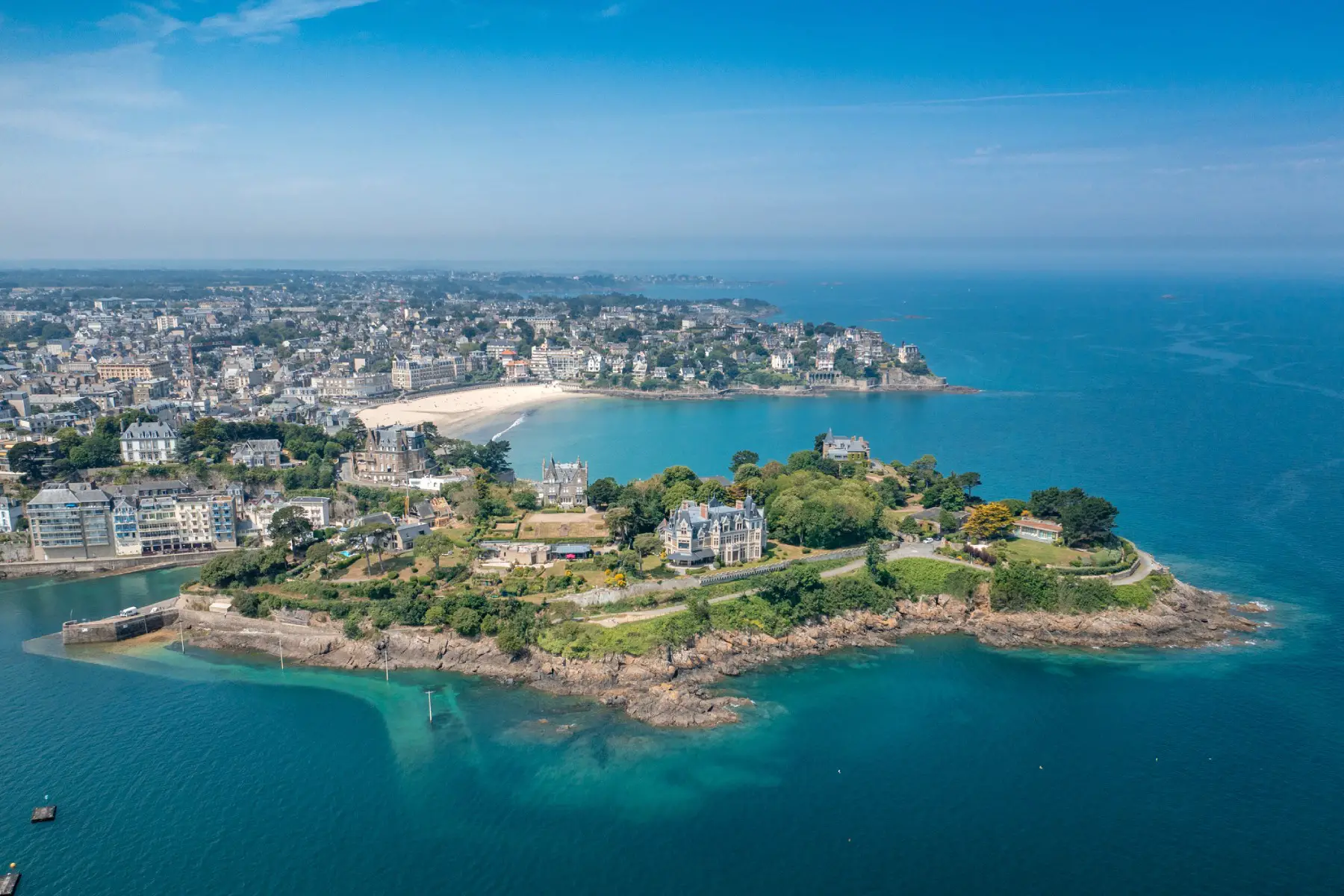
Dinard is also ideal for those who are interested in outdoor activities and who prefer a quieter, more laid-back lifestyle. Residents can participate in water activities, golf, and walks by the coast while savoring tasty seafood in local restaurants.
The town’s close proximity to Saint-Malo also provides access to extra amenities and the two are well connected by a ferry service.
However, while Dinard is a great place to live, it has also been a holiday destination since the 1860s. As a result, the town tends to see an influx of tourists, particularly during the warmer summer months.
It is also worth noting that living costs, especially when it comes to housing, can be quite high in the area. For example, the average monthly rent for apartments in the area was €1,188 in October 2023, which is almost on par with Rennes.
Rennes
Brittany’s capital city is a great place to explore the region’s history, culture, and modern life. It is home to numerous historic buildings, such as Rennes Cathedral, which sits among more modern landmarks.
The city takes also great pride in its Breton culture, offering traditional music, dance, and festivals. It is also a foodie haven in which residents can savor a variety of traditional Breton dishes, such as galettes, in its restaurants, cafes, and markets, including the Lices Market (Marché des Lices).
Notably, Rennes is a dynamic city and home to a large student population, owing to its numerous schools, colleges, and universities. As a result, it welcomes residents from all corners of the globe.
Getting around Rennes is also simple thanks to its efficient public transport system. Not only is it accessible from the motorway, high-speed train line, and Rennes Bretagne Airport, but it also has an easy-to-use STAR network which includes a metro, buses, and bike rental service.
This makes it possible to explore the city and its surroundings however you like. Notably, cycling is a good option given that parking in Rennes is expensive and challenging to find.
Rennes is also quite family-friendly and offers plenty of activities for kids. This includes the Espace des Sciences (Science Centre), the Musée des Beaux Arts (Fine Arts), and the Parc du Thabor (Thabor Gardens).
That said, it is important to keep in mind that some central areas can get a bit noisy, and housing costs can be on the higher side. On the other hand, the average rent for a one-bedroom apartment in Rennes was €1,221 in October 2023, which is less than some areas of Brittany, such as Saint-Malo by the coast.
Saint-Brieuc
The capital of the Côtes-d’Armor department, Saint-Brieuc is ideal for those who enjoy cycling, hiking, delicious food, and an active art scene.
The city stays lively throughout the year due to its central location on Brittany’s northern coast. Events such as the Art-Rock festival and traditional Breton Fest Noz dances are also popular with locals and visitors alike. Moreover, you can easily access other areas of the region from Saint-Brieuc.
The city has a rich history and culture that is influenced by Celtic, Gallo, and Breton traditions. You can see this in the historic center which features half-timbered medieval houses and the 15th-century Cathédrale Saint Étienne.
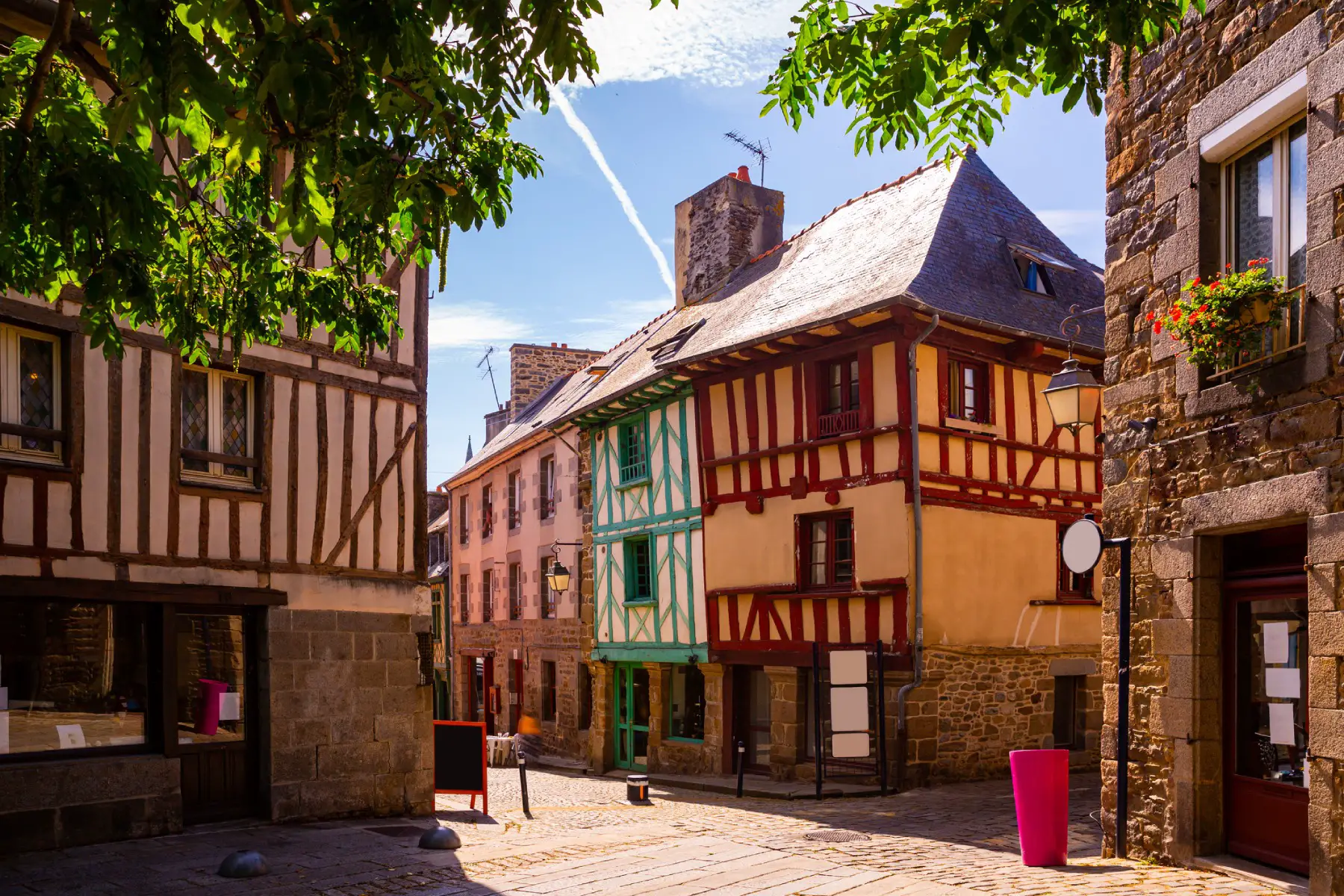
You can also explore the beautiful scenery and protected natural environment of Saint-Brieuc Bay, which is one of the largest national nature reserves in France. Notably, it is also known for its impressive tides which makes it a surfer’s paradise.
Aside from nature, Saint-Brieuc boasts a lively restaurant scene with numerous eateries serving delicious local produce and crêperies offering Breton pancakes. Specialties include Coquilles Saint-Jacques – or king scallops – the crowning glory of the bay.
If you are looking to buy or rent a property in Saint-Brieuc, there are a few different options. For instance, you can rent an apartment in the city center or look for a more secluded house in the suburbs. These latter are typically arranged around courtyards or situated on spacious pieces of land.
If you are looking for a property near a river with a unique atmosphere, on the other hand, then a mill property might be worth considering.
However, it is worth noting that rental prices in Saint-Brieuc are relatively high, with a one-bedroom apartment averaging €1,302 in October 2023.
Saint-Malo
If you want to live in a peaceful coastal environment, then Saint-Malo might be a good option.
While it is a popular tourist destination, it also warmly welcomes residents from diverse backgrounds. Moreover, it is home to various parks and open spaces, making it perfect for relaxed walks and family outings.
In addition, Saint-Malo’s crime rates are 43% lower than the national average, which contributes to its high quality of life. That said, as is the case in most big cities, pickpocketing is common at train stations, on buses, and even at airports. Therefore, it pays to be alert.
In terms of socializing, Saint-Malo has many pubs and restaurants where locals can get together and enjoy fresh seafood and other local specialties. Those who love culture and architecture can also visit Les Remparts de Saint-Malo (the medieval city walls) and La Ville Intra-Muros (the walled city).
Getting around Saint-Malo is also convenient with public transport, which allows residents to reach the city center in a reasonable amount of time. Although buses are the most convenient option, you can also get around by car.
In conclusion, Saint-Malo is best for those seeking a serene coastal lifestyle with a focus on family-oriented living. The high quality of life and close proximity to the beach also make it an appealing destination for those seeking a peaceful life by the sea.
That said, rental prices in Saint-Maloare slightly more than in Rennes, with the average rent for a one-bedroom apartment costing €1,461 in October 2023.
Quimper
If you want to feel like you are living in a fairy tale, then Quimper is the place to be. The picturesque capital of the Finistère department is full of history and home to cobbled streets lined with charming houses.
It is also located near the Odet River and Atlantic Coast which means that you can enjoy fresh seafood on your doorstep. That said, Quimper’s specialty is actually crêpes, which you can find in the many eateries dotted around the town.
Quimper is also famous for its beautiful faience pottery, which developed in the 17th century. This is characterized by its bright, hand-painted motifs of fruit and flowers.
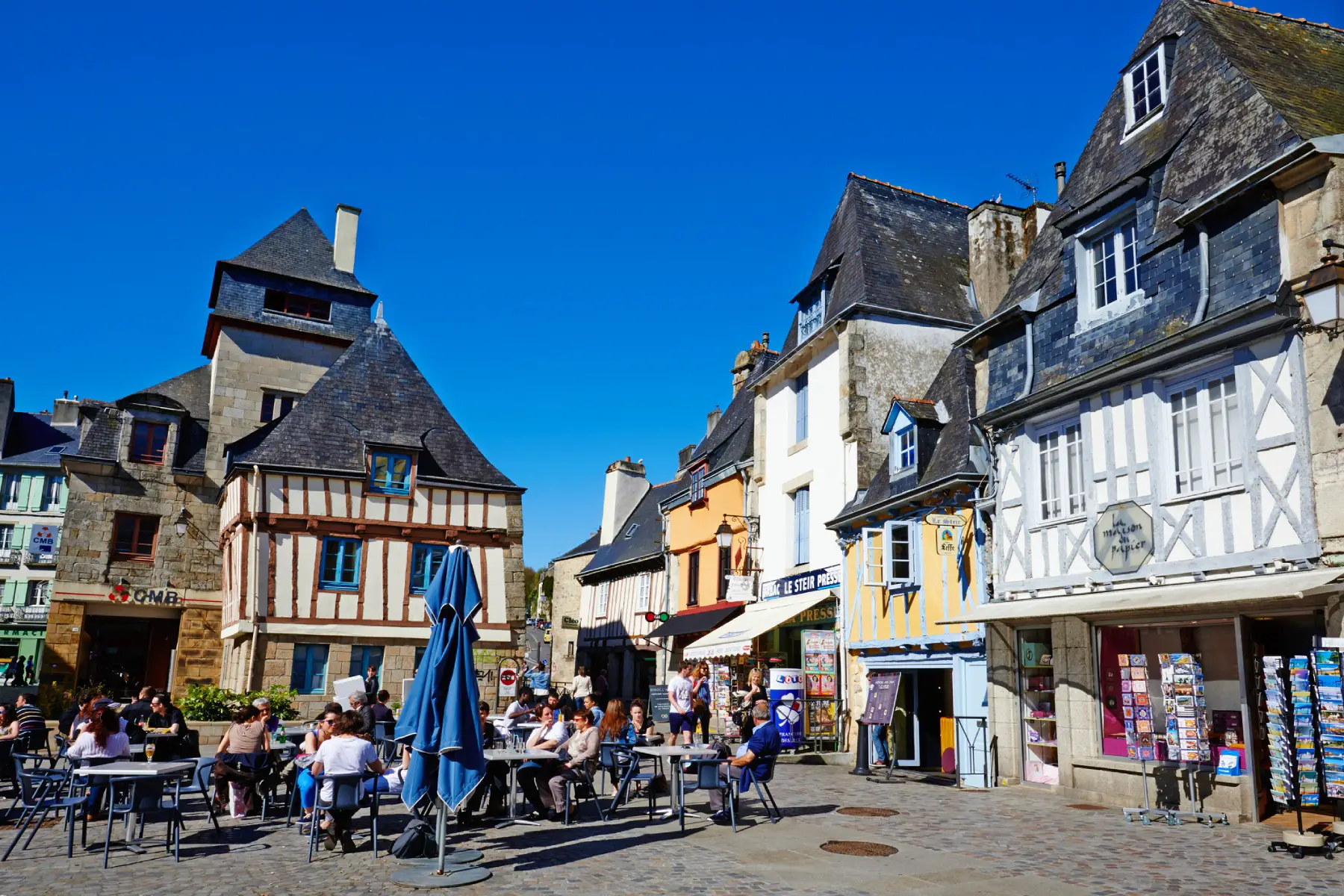
Overall, the town offers a relaxed and friendly atmosphere with a strong sense of community. This is evident during events such as the annual Festival de Cornouaille (Cornwall Festival) which celebrates the songs, dances, and music of Brittany and other world cultures.
Quimper’s blend of history, culture, and nature makes it an appealing place to live among those who appreciate a leisurely lifestyle and seek a close-knit community. It is also family-friendly, with a range of good schools and healthcare facilities in the area, which are easily accessible by public transport.
That said, rental prices can be steep, with a one-bedroom apartment averaging €1,557 in October 2023. Of course, the exact cost can vary based on factors such as location and property size.
Is Brittany a safe place to live?
Many people believe that Brittany, just like many other places in France, is generally a safe place to live.
Indeed, its relatively low crime level (in comparison to Paris) and high quality of life make it an appealing option for those looking to settle in the region.
That said, pickpockets are the most common perpetrators of crimes at train stations, on buses, and in bigger cities in the region.
It is also important to keep in mind that safety can vary between different towns and neighborhoods. Therefore, it is important to thoroughly research each area and choose where you live carefully. Of course, it is also wise to take common-sense safety measures to make sure you remain safe in Brittany.
How do you choose where to live in Brittany?
Like anywhere, there are several factors to consider when looking for a place to live in Brittany.
For example, do you want somewhere with the best transport links to a particular area such as where you work? Are certain amenities important to you, such as parks, schools, bars, cultural activities, or family attractions? Or is being in a more vibrant area with an active nightlife scene a bigger priority? Perhaps you would prefer a more secluded coastal town away from it all? Or maybe you are simply looking for somewhere with lower overall costs?
Whatever you are looking for, it is advisable to carefully research each area before making a decision. This could involve:
- Doing some online research on particular cities or towns in Brittany
- Joining social media forums and speaking to expats who already live in the region
- Looking at property websites to get an idea of the standard of accommodation and property/rental costs
- Visiting Brittany to check out the different areas in person
It may also help to make a list of the positive and negative aspects of each location you are considering to help you decide which best fits your needs and lifestyle.
Useful resources
- Brittany Tourism – the official tourism website for Brittany which provides information on all towns and cities in the region
- Destination Rennes – the tourism website for Rennes with information about culture and events in the region’s capital
- Région Bretagne (in French) – the website of the Brittany Regional Council which offers information and news related to the region
